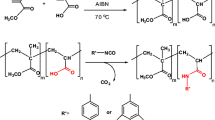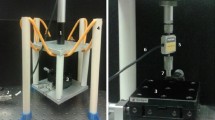Abstract
Some novel radiopaque biodegradable and biocompatible iodinated polymers based on poly-3-hydroxy butyrate (PHB) were obtained. Following the attachment of diethanol amine to PHB, the hydroxyl ends were capped with 4-iodobenzoic acid and 2,3,5-tri-iodobenzoic acid. In this manner, tri-novel radiopaque polymers were obtained. The resulting polymers were structurally characterized by NMR technique. They were evaluated with respect to their possible use as radiopaque implant biomaterials indicating X-ray visibility in a noninvasive manner using routine X-ray absorption imaging techniques. These polymers exhibited good radiopacity with conventional imaging X-ray techniques in vivo. Additionally, biocompatibility of these iodinated polymers was also evaluated. There were no signs of infection or abscess formation on the surgical area. These novel radiopaque PHBs should be promising biomaterials for a new-generation radiopaque materials.







Similar content being viewed by others
References
Gross RA, DeMello C, Lenz RW, Brandl H, Fuller RC (1989) The biosynthesis and characterization of poly (β-hydroxyalkanoates) produced by Pseudomonas oleovorans. Macromolecules 22:1106
Lenz RW, Marchessault RH (2005) Bacterial polyesters: biosynthesis, biodegradable plastics and biotechnology. Biomacromolecules 6:1
Solaiman DKY, Ashby RD, Foglia TA, Marmer WN (2006) Conversion of agricultural feedstock and coproducts into poly(hydroxy alkanoates). Appl Microbiol Biotechnol 71:783
Steinbüchel A (2001) Perspectives for biotechnological production and utilization of biopolymers: metabolic engineering of polyhydroxyalkanoate biosynthesis pathways as a successful example. Macromol Biosci 1:1
Koray O, Koksal MS, Hazer B (2010) Simple production experiment of poly (3-hydroxy butyrate) for science laboratories and its importance for science process skills of prospective teachers. Energy Educ Sci Technol Part B Soc Educ Stud 2, 1–2:39
Steinbüchel A, Valentin HE (1995) Diversity of bacterial polyhydroxyalkanoic acids. FEMS Microbial Lett 128:219
Ishii D, Takisawa K, Matsumoto K, Ooi T, Hikima T, Takata M, Taguchi S, Iwata T (2017) Effect of monomeric composition on the thermal, mechanical and crystalline properties of poly [(R)-lactate-co-(R)-3-hydroxybutyrate]. Polymer 122:169
Scholz C, Fuller RC, Lenz RW (1994) Growth and polymer incorporation of Pseudomonas oleovorans on alkyl esters of heptanoic acid. Macromolecules 27:2886
Tappel RC, Kucharski JM, Mastroianni JM, Stipanovic AJ, Nomura CT (2012) Biosynthesis of poly [(R)-3-hydroxyalkanoate] copolymers with controlled repeating unit compositions and physical properties. Biomacromolecules 13:2964
Toraman T, Hazer B (2014) Synthesis and characterization of the novel thermoresponsive conjugates based on poly (3-hydroxy alkanoates). J Polym Environ 22:159
Hazer DB, Kilicay E, Hazer B (2012) Poly (3-hydroxyalkanoate) s: diversification and biomedical applications: a state of the art review. Mater Sci Eng C 32:637
Scandola M, Focarete ML, Adamus G, Sikorska W, Baranowska I, Swierczek S, Gnatowski M, Kowalczuk M, Jedlinski Z (1997) Polymer blends of natural poly (3-hydroxybutyrate-co-3-hydroxyvalerate) and a synthetic atactic poly (3-hydroxybutyrate). Characterization and biodegradation studies. Macromolecules 30:2568
Hazer B, Akyol E, Şanal T, Guillaume S, Çakmakli B, Steinbuchel A (2019) Synthesis of novel biodegradable elastomers based on poly [3-hydroxy butyrate] and poly [3-hydroxy octanoate] via transamidation reactio. Polym Bull. https://doi.org/10.1007/s00289-018-2410-2
Sparks J, Scholz C (2008) Synthesis and characterization of a cationic poly (β-hydroxyalkanoate). Biomacromolecules 9:2091
Lorenzini C, Versace DL, Renard E, Langlois V (2015) Renewable epoxy networks by photoinitiated copolymerization of poly (3-hydroxyalkanoate) s and isosorbide derivatives. React Funct Polym 93:95
Hazer B (2015) Simple synthesis of amphiphilic poly (3-hydroxy alkanoate) s with pendant hydroxyl and carboxylic groups via thiol-ene photo click reactions. Polym Degrad Stab 119:159
Abe H, Doi Y, Kumagai Y (1994) 3-hydroxybutyrate-β-6-hydroxyhexanoate] as a compatibilizer for a Biodegradable Blend of Poly [(R)-3-hydroxybutyrate] and Poly (6-hydroxyhexanoate). Macromolecules 27:6012
Hazer DB, Hazer B (2011) The effect of gold clusters on the autoxidation of poly (3-hydroxy 10-undecenoate-co-3-hydroxy octanoate) and tissue response evaluation. J Polym Res 18:251
Hazer B (2010) Amphiphilic poly (3-hydroxy alkanoate) s: potential candidates for medical applications. Int J Polym Sci. https://doi.org/10.1155/2010/423460
Chen GQ (2009) A microbial polyhydroxyalkanoates (PHA) based bio-and materials industry. Chem Soc Rev 38:2434
Hazer DB, Bal E, Nurlu G, Benli K, Balcı S, Öztürk F, Hazer B (2013) In vivo application of poly-3-hydroxyoctanoate as peripheral nerve graft. J Zhejiang Univ Sci B (Biomed Biotechnol) 14(11):993
Hazer B, Steinbüchel A (2007) Increased diversification of polyhydroxyalkanoates by modification reactions for industrial and medical applications. Appl Microbiol Biotechnol 74:1
Arkin AH, Hazer B, Borcakli M (2000) Chlorination of poly (3-hydroxy alkanoates) containing unsaturated side chains. Macromolecules 33:3219
Arkin AH, Hazer B (2002) Chemical modification of chlorinated microbial polyesters. Biomacromolecules 3(6):1327
Yalcin B, Cakmak M, Arkın AH, Hazer B, Erman B (2006) Control of optical anisotropy at large deformations in PMMA/chlorinated-PHB (PHB-Cl) blends: mechano-optical behavior. Polymer 47:8183
Arkin AH, Hazer B, Adamus G, Kowalczuk M, Jedlinski Z, Lenz RW (2001) Synthesis of poly (2-methyl-3-hydroxyoctanoate) via anionic polymerization of α-methyl-β-pentyl-β-propiolactone. Biomacromolecules 2(3):623
Wang Q, Qian K, Liu S, Yang Y, Liang B, Zheng C, Yang X, Xu H, Shen AQ (2015) X-ray visible and uniform alginate microspheres loaded with in situ synthesized BaSO4 nanoparticles for in vivo transcatheter arterial embolization. Biomacromolecules 16:1240
Nuutınen J-P, Clerc C, Törmälä P (2003) Mechanical properties and in vitro degradation of self-reinforced radiopaque bioresorbable polylactide fibres. J Biomater Sci Polym Ed 14:665
Lee BH, Leon C, McLemore R, Valdez Macias J, Vernon BL (2011) Synthesis and characterization of thermo-sensitive radio-opaque poly (N-isopropylacrylamide-co-PEG-2-iodobenzoate). J Biomater Sci Polym Ed 22:2357
Sang L, Wei Z, Liu K, Song K, Wang J, Qi M (2014) Radiopaque iodinated polyurethane for embolic agents. Acta Polym Sin 1:31
Wei Z, Song P, Sang L, Liu K, Zhou C, Wang Y, Li Y (2014) Radiopaque iodinated poly (ester–urethane) s based on poly (butylene succinate): retarded crystallization and dual recrystallization behaviour. Polymer 55:2751
Li S, Yu J, Wade MB, Policastro GM, Becker ML (2015) Radiopaque, iodine functionalized, phenylalanine-based poly (ester urea) s. Biomacromolecules 16:615
Meng WJ, Lu XJ, Wang H, Fan TY, Cui DC, Zhang SS, Zheng ZZ, Guan HT, Song L, Zou YH (2015) Preparation and evaluation of biocompatible long-term radiopaque microspheres based on polyvinyl alcohol and lipiodol for embolization. J Biomater Appl 30(2):133–146
Dawlee S, Jayakrishnan A, Jayabalan M (2009) Studies on novel radiopaque methyl methacrylate: glycidyl methacrylate based polymer for biomedical applications. J Mater Sci Mater Med 20:S243–S250
van Hooy-Corstjens CSJ, Aldenhoff YBJ, Knetsch MLW, Govaert LE, Arin E, Erli H, Koole LH (2004) Radiopaque polymeric spinal cages: a prototype study. J Mater Chem 14:3008
Boelen EJH, Lewis G, Xu J, Slots T, Koole LH, van Hooy-Corstjens CSJ (2008) Evaluation of a highly‐radiopaque iodine‐containing acrylic bone cement for use in augmentation of vertebral compression fractures. J Biomed Mater Res 86A:76
Estep KG, Josef KA, Bacon ER, Illig CR, Toner JL, Mishra D, Blazak WF, Miller DM, Johnson DK, Allen JM, Spencer A, Wilson SA (2000) 1,3,5-Trialkyl-2,4,6-triiodobenzenes: novel X-ray contrast agents for gastrointestinal imaging. J Med Chem 43:1940
Benzina A, Kruft MAB, Bar F, Vanderveen FH, Bastiaansen CW, Heijnen V, Reutelingsperger C, Koole LH (1994) Studies on a new radiopaque polymeric biomaterial. Biomaterials 15:1122
Aldenhoff YBJ, Kruft MAB, Pijpers AP, van der Veen FH, Bulstra SK, Kuijer R, Koole LH (2002) Stability of radiopaque iodine-containing biomaterials. Biomaterials 23:881
Tuzen M, Sahiner S, Hazer B (2016) Solid phase extraction of lead, cadmium and zinc on biodegradable polyhydroxybutyrate diethanol amine (PHB-DEA) polymer and their determination in water and food samples. Food Chem 210:115
Neises B, Steglich W (1978) Simple method for the esterification of carboxylic acids. Chem Int Ed 17:522
Hazer DB, Hazer B, Dinçer N (2011) Antibacterial effects of laser ablated Ni nanoparticles. J Biomed Biotechnol 2011:956169. https://doi.org/10.1155/2011/956169
Hazer DB, Hazer B, Kaymaz F (2009) Synthesis of microbial elastomers based on soybean oily acids. biocompatibility studies. Biomed Mater 4(3):035011. https://doi.org/10.1088/1748-6041/4/3/035011
Shishatskaya EI, Khlusov IA, Volova TGA (2006) A hybrid PHB–hydroxyapatite composite for biomedical application: production, in vitro and in vivo investigation. J Biomater Sci Polym Ed 17(5):481
Nygren CL, Wilson CC, Turner JFC (2005) On the solid state structure of 4-iodobenzoic acid. J Phys Chem A 109:2586
Zhao F, Yao D, Guo R, Deng L, Dong A, Zhang J (2015) Composites of polymer hydrogels and nanoparticulate systems for biomedical and pharmaceutical applications. Nanomaterials (Basel) 5(4):2054
Rodriguez JN, Yu YJ, Miller MW, Wilson TS, Hartman J, Clubb FJ, Gentry B, Maitland DJ (2012) Opacification of shape memory polymer foam designed for treatment intracranial aneurysms. Ann Biomed Eng 40(4):883
Acknowledgements
This work was supported by the Kapadokya University (#KÜN.2018-BAGP-001) and Bülent Ecevit University Research Funds (#BEU-2017-72118496-01). The authors thank to Fatih Pekdemir for taking FTIR spectra. This paper has been proofread by Bülent Ecevit University Article Proofreading and Editing Office.
Author information
Authors and Affiliations
Corresponding author
Ethics declarations
Conflict of interest
The authors declare that there is no conflict of interest.
Additional information
Publisher's Note
Springer Nature remains neutral with regard to jurisdictional claims in published maps and institutional affiliations.
Rights and permissions
About this article
Cite this article
Erol, A., Rosberg, D.B.H., Hazer, B. et al. Biodegradable and biocompatible radiopaque iodinated poly-3-hydroxy butyrate: synthesis, characterization and in vitro/in vivo X-ray visibility. Polym. Bull. 77, 275–289 (2020). https://doi.org/10.1007/s00289-019-02747-6
Received:
Revised:
Accepted:
Published:
Issue Date:
DOI: https://doi.org/10.1007/s00289-019-02747-6




